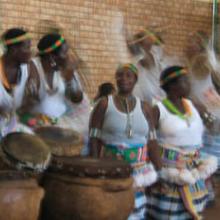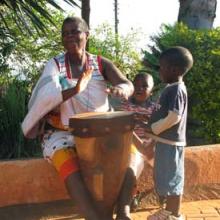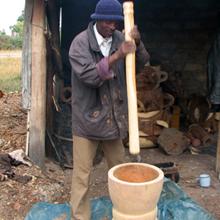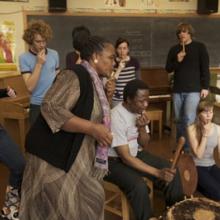In 1973 John Blacking’s How Musical Is Man? was published by University of Washington Press. Blacking, an English anthropologist and ethnomusicologist, had been invited to the University of Washington as a Jessie and John Danz Lecturer in 1971, and his series of talks became the basis for this published work. How Musical Is Man? explores the role of music in society and culture and, conversely, the role of culture and society in music. Blacking draws on his field research with the Venda people of the Northern Transvaal, South Africa as well as his own musical background to demonstrate the relationships between patterns of sound and patterns of human organization inherent to all societies.
In response to requests for recordings of the musical examples in How Musical Is Man?, Blacking provided the University of Washington Ethnomusicology Archives with an audio tape of samples of his own recordings of Venda music to make available for distribution. This music, along with Blacking's accompanying notes, is now available here as streamed audio.
Blacking's notes include the following explanation:
"The items on this tape, mostly excerpts from longer recordings, have been selected to complement, not necessarily to duplicate, the musical examples in How Musical Is Man?....Thus alternative or "deviant" versions of songs that are in the book have been included, as well as music that is not in the book. In the following notes, the abbreviation HM stands for How Musical Is Man? ; VC stands for Venda Children's Songs by John Blacking (Johannesburg: Witwaterstrand University Press, 1967)."
Track 1
Tshikona tsha Shakadza, 1956. The Venda national drama for reed pipes, played by men, and drums, played by woman; performed at Thengwe by the people of Shakadza, who were called to the chief’s capital. (1:30)
Track 2
Nyimbo dza vhana (children’s songs). See VC; also HM, pp. 90-97.
a) Ndo bva na tshidongo (“I walked out with a small dish”), VC, No. 50, an unusually long and original version sung by Tshinakaho Phafula of Luvhimbi in 1957. (1:00)
b) Two different versions of Funguvhu, tanzwa mulomo! (“Crow, wash your mouth!”), VC, No. 41, followed by Kula kwe’ Ndi vho-nnyi vhala? (“That little one said, ‘Who is that?’”), VC, No. 45, sung respectively by Johannes Tshikudo and Takalani Temudzani of Thengwe in 1957. See HM, p. 24. (1:20)
c) Maelele! Mapengo thi mu funi zwone (“I love Mapengo very dearly”), VC, No. 38, sung by Matodzi Ne-Thengwe and Masindi Tshikudo of Thengwe in 1958. See HM, p. 70. (0:30)
d) Thoho yanga i a rema (“My head aches”), VC, No. 36, sung by Miriam Netshilema of Duthuni in 1960. (0:41)
e) Thathatha!Tsindi i na nnda (“Thathatha! The loincloth is full of lice”), VC, No. 56, a song without a melody sung by Zwodangani Ne-Thengwe of Thengwe in 1956. See HM, p. 28, for another song of the same type. (0:35)
f) Two versions of Inwi haee Nyamudzunga! (“Hullo there, Nyamudzunga!”), VC, No. 34, sung by Zwodangani and Selina Ne-Thengwe of Thengwe and Gilbert Ligege of Duthuni in 1956. See HM, p. 70. (0:25)
g) Nde’ ndi ngei thavhani (“When I was there on the mountainside”), VC, No. 47, sung by Nkhumeleni Ralushai of Ha Ralushai, near Mbilwi, in 1956. (0:30)
Track 3
Mutshaini, a melody for pentatonic reed pipes and drums, played in Meadowlands, Soweto, Johannesburg, by a team led by Petrus Liuvha and Johannes Doboro. Note the introductory call on the phalaphala (see HM, illus. following p. 50), a side-blown horn made from the horn of a sable antelope or kudu. See also HM, Fig. 12, p.97. (3:20)
Track 4
Vho-mme vho ya ngafhi? (“Where has your mother gone?”), a song for girls, VC, No. 33, sung by Tshenwane and Selina Ne-Thengwe of Thengwe in 1957. Cf. the melody of No. 5, following, Mangovho, and see HM, p. 97. (0:15)
Track 5
Mangovho, a melody for pentatonic reed pipes and drums, performed by the same group as No. 3. (1:30)
Track 6
Ndo todou fa (“I nearly died”), song for tshipai dancing, normally played on pentatonic reed pipes and drums and similar to Mutshaini and Mangovho, here played on a 13-note mbira (mbila tshipai, see HM, illus. facing p. 50), by Wilson Maduna of Ramadi, Tshakhuma, in 1956. (0:20)
Track 7
Transformations of tshikona (Ex. 1), the Venda national dance.
a) On mbila tshipai, played by Petrus Nengwani in 1956 at Tshakhuma. The mbira had 15 keys. (0:16)
b) Tshikona, as played on reed pipes. (0:20)
c) On mbila dza madeza, played by Mattheus Mutswaletswane of Vondo in Meadowlands, Soweto, in 1963. (0:15)
d) Two versions on tshihwana musical bow (see HM, illus. following p. 50), played by Tshidavhula Madiya and Tshinanne Mashau of Tshakhuma, respectively, in 1956. (0:20)
e) On tshizambi friction bow, played by Samson Redi of Lufule in 1957. (0:20)
f) On tshizambi friction bow, played by Samson Redi of Lufule in 1957. (0:20)
Track 8
Instrumental music: wind instruments.
a) Solo for dilitili flute (see HM, illus. following p. 50), played by Ratshilumela Mufanadzo of Magidi in 1958; followed by “words” by which the melody is remembered, and then a second tune called Tshitereke, whose words are sung by Mboneni Ramaposwo. (2:15)
b) Three tunes for ocarina (tshipotoliyo) duet played by Alfred Tshibalanganda and Flaubert Netshikwati of Gaba in 1957. See tunes A, C, and B in HM, Fig. 3, p. 20. (1:20)
c) Tune for tshitiringo three-holed transverse flute played by Alfred Mukwevho of Ngwenani in 1956. (0:25)
Track 9
Instrumental music: stringed instruments.
a) Song with galinga earth bow, played by Tshitereke Mbengeni of Magidi in 1958. (0:45)
b) A rare performance by a man on lugube musical bow, by Aaron Mulaudzi of Tshakhuma in 1956; followed by a version of the public song of the boys’ circumcision school (murundu) performed by a group of girls at Tshivhambe in 1956, accompanied on lugube by Nyamukamadi. (0:55)
c) A well-known song for tshihwana musical bow played by Thivhiliheni Ne-Thengwe in 1958. The string broke and could not be satisfactorily repaired. The song is Tshidudu tsha makhulu Matodzi (“The small clay pot for my grandmother Matodzi”). (0:25)
d) A song with tshidzholo one-stringed fiddle by Gena Mohali, a Pedi who lived in Tshakhuma in 1956. (0:30)
e) A song with dende musical bow (see HM, illus. following p. 50), by Ramudzuli Magadagela in 1956 at Phiphidi. (1:00)
Track 10
Instrumental music: mbira and xylophone.
a) For mbila tshipai: (i) A walking tune for going to amalaita boxing at the cattle dip (see Pl. 5 in VC), played in 1956 by Samuel Shipango of Lambani. (ii) and (iii) two Amalaita duets played in 1956 by Johannes Hanyani (Shangana-Tsonga) of Tshivhambe, assisted by Joseph Makungo (Venda). (2:00)
b) For mbila dza madeza: (i) Vho-Muzila and (ii) Tsha Madekwe, played by Mattheus Mutswaletswane of Vondo in Meadowlands, Soweto, in 1963, accompanied by friends who sing the chorus. (2:25)
c) For mbila mtondo xylophone: Hu na Nya-mu-takala-nga-u-la (“It is Madam Happy-whenever-she-is eating.”) This is an old song, said to be the original of Vho-Muzila (see bi, above), which was the name given to it in honor of Ramaremisa, Chief Tshivhase in the 1930s. Played by William Marubini Madobi and George Lugiseni Madobi of Mbaleni, in 1957. See photo taken during performance, HM, following p. 50. (2:20)
Track 11
Story-songs for children (ngano).
a) The story of a man and his wife and the fruit tree, told by Munzhedzi Mmbi of Gaba in 1958, accompanied by children and friends. (2:10)
b) Tshinoni tsha Musenzhe (“The bird of Musenzhe”), a song from a story, sung by Munzhedzi Mmbi of Gaba and companions in 1958. (0:40)
c) The song from a story about a girl who changed into a bird and warned a man not to eat, sung by Tshikale Munaka with girls from Thengwe in 1958. (0:20)
Track 12
Children’s play-songs (dzhombo).
a) Tshikhakhiso Romane, sung by girls at Thengwe, led by Tshikale Munaka, in 1958. (1:15)
b) Phetha-tshigele, sung by the same group as a. A version of this is sung at the vhusha initiation school. See HM, Ex. 8, p. 40. (0:20)
Track 13
The girls’ play-dance, tshigombela. Three excerpts from a 20-minute performance by girls from Magidi, led by Tshidavhula Vhuromu at Tshivhambe, while on bepha musical expedition in 1958: (a) shortly after the beginning of the song Nne ro betsha, leg rattles are audible as the girls dance round in a circle; (b) the pitch has risen, and the chorus sounds different after about 10 minutes; (c) the whistles are blown energetically by girls who come out to dance in pairs and threes, and the end of the dance is signaled by an iambic beat on the drum. See HM, illus. following p. 18. (3:10)
Track 14
Music of the girls’ initiation school, sungwi or musevhetho. See HM, pp. 40-41.
a) Luimbo lwa u sevhetha (song for dancing round): Ha Maguvhulele, sung by Nyamulatshawe Rananga and novices and graduates of Lurale’s school, Mbaleni, in 1957. (2:05)
b) Luimbo lwa vhahwira (song of the masked dancers): Maovhelwana, sung by Tshavhungwe Makuya and members of Lurale’s school in 1958. See HM, illus. following p. 18. (0:45)
c) Luimbo lwa dzingoma (song for a special rite): Phephenyane i a nnduma tswaroni (“Phephenyane is biting me in the thighs”), sung by the same group as in b. While singing this, novices must walk along holding sharpened sticks between their thighs. (0:45)
d) Luimbo lwa milayo (song of the laws of the school): Sankwanye marunda (“It presses down on my shoulders”), led by the spirit of the school (with kazoo-like instrument called mufuni or sitlanjani), who is called Nonyana, and sung by the same group as in a in 1957. (0:50)
e) Mutsha, one of the masked dancers, speaks to the novices in whistle language. (0:35)
Track 15
A modern school song, exhorting the Venda people to study hard and diligently, sung by pupils at the primary school at Thengwe in 1958, led by their teacher, Martin Simeli. (1:00)
Track 16
A hymn of the Zionist Separatist Churches, sung early in the morning toward the end of an all–night service preceding the opening of a new shop in Sambandou on 29 November 1958. (1:00)
Track 17
Music of the possession cult, Gaba, 1958.
a) Tshele, sung by women accompanied with hand rattles, indoors, prior to the public dance of possession. (0:45)
b) Ngoma dza midzimu, sung by members of the cult and others, accompanied by drums. See HM, illus. following p. 18. (1:45)
Track 18
Songs of the vhusha and tshikanda initiation schools for girls.
a) Muulu, sung with lower lips flapped with the forefinger to warn people that the school is in progress, at Lukau in 1958. See HM, p. 38, Ex. 6. (0:30)
b) Xaxaee! Ri toda mutei (“Haha! We are looking for a novice”), the song by which girls are summoned and taken from their homes to the council hut for instruction, sung at Thengwe in 1958. (0:40)
c) Vhusha, the ritual song of the school, sung at Thengwe in 1958. Note the characteristic rhythm and the khulo style of singing. (2:05)
d) Phetha-tshigele, a song to accompany ndayo dancing, sung at Thengwe in 1958. See HM, p. 40 and illus. following p. 18. See also dzhombo song (12/b). (0:35)
e) Rejoicing on the last night of tshikanda at Lukau in 1957. Sounds of phalaphala horn being blown by women, and also the pembela rhythm on the bass drum. (0:20)
Track 19
The great song of the domba premarital initiation, performed by Jack Makumbila Nemukula and novices and graduates of domba at Thengwe, 1958. (4:10)
a) Heard from a distance, with sounds of night insects. (0:30)
b) The beginning of the song, leading to khulo. See HM, pp. 81-84 ff. (2:00)
c) Close-up of khulo. (1:00)
d) Last section of the song. (0:40)
Track 20
Learning how to sing pounding songs (mafhuwe) at domba, instructed by Jack Makumbila at Thengwe in 1958. (0:35)
Track 21
Two beer songs (malende), sung at Gaba in 1958.
a) Ri a shalela, led by Piet Tshibalanganda. (1:10)
b) Vivho vha nalo (“They are jealous”), led by Munzhedzi Mutshinyalo. (0:55)
Track 22
Tshikona tsha Shakadza in 1958. Some close-ups of the different players interacting to produce the whole pattern from combinations of single tones, each played on a separate pipe; performed at Shakadza, near the headman's home. (1:15)
The University of Washington Ethnomusicology Archives dedicates this page to the memory of John Blacking. It was made possible through the efforts of Cecilia Jezek, John Vallier, Andrea Emberly, and Mudzunga Junniah Davhula.









